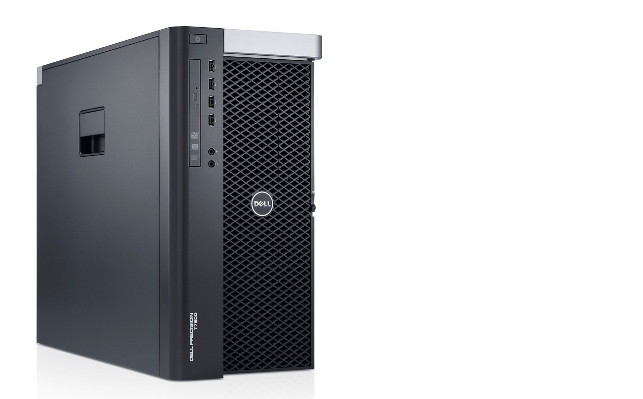Dell first unveiled the Precision T7600 in April 2012.

Timed to coincide with the launch of Intel’s ‘Sandy Bridge’ Xeon processors, the machine also heralded what was arguably the biggest re-design in the history of Dell Precision workstations.
With a stylish aluminium chassis, the T7600 is hot on looks, but the most impressive thing about the design is its serviceability.
Hard drives that pop out from the front, a rear facing power supply that can be replaced in seconds and well ordered internal components are the standout features.
A completely re-engineered thermalmanagement system means there’s little to worry about when it comes to noise. Low duty fans draw air in at the front of the machine — cooling the CPUs, memory and hard drives — before being expelled at the rear.
The downside of this CFD-optimised design is you can really feel the hot air coming out of the back of the machine at peak loads. We pity the engineer who sits directly opposite.
Kitted out with two eight core 3.1GHz Xeon E5-2687W chips, our test machine is literally brimming with processing power.
With a total of 32 threads (16 physical and 16 hyperthreading) the T7600 blitzed our 3ds Max benchmark, rendering an HD scene in 79 seconds.
The T7600 also shows itself to be very adept at multi-tasking with little slow down when calculating two and three CAM toolpaths concurrently in PowerMill.
Our test machine’s high-end pedigree doesn’t stop with CPUs. There’s close to £1,500 of storage technology inside, including a 146GB SAS (15,000RPM) for OS and apps and two 600GB SAS 10,000RPM) hard drives (RAID 0) for data.
RAID is handled by a PERC H710P PCI Express controller. This highperformance controller is usually deployed in data-intensive servers so may be overkill for many workstation-based design workflows.
For graphics, Dell has chosen the mid-range AMD FirePro V7900. It’s a solid 3D card, but will soon be replaced by AMD’s new FirePro W Series Southern Island GPUs.
Nvidia’s new Kepler-based Quadro K5000 is also on Dell’s roadmap so it may be worth waiting to get the most up to date graphics technology.
As a machine, we’re hugely impressed with Dell’s Precision T7600. It’s well-built, sleek, and incredibly easy to service — possibly the best dual Xeon workstation we’ve seen.
Our test machine is probably a little too high-end for most CAD/CAM/CAE users but some tweaks here and there should bring the price down.
Meanwhile, to learn more about the T7600’s chassis click here
Greg Corke
To view comparative scores from other workstations please click here
For details of all our specific CAD/CAM/CAE benchmarks click here
Specifications
» 2 x Intel Xeon E5-2687W (eight core)(3.1GHz) CPU
» 16GB (4X4GB)1,600MHZ DDR3 ECC RDIMM memory
» AMD FirePro V7900 (2GB) graphics
» 146GB 2.5-inch SAS (15,000RPM) + 2 x 600GB 2.5-inch SAS (10,000RPM) hard drives (RAID 0)
» PERC H710P SATA/SAS controller
» Dell motherboard (Intel C600 series chipset)
» Microsoft Windows 7 Professional 64-bit
» 3 year ProSupport and Next Business Day On-Site Service
CPU benchmarks
(secs – smaller is better)
CAD (SolidWorks 2010) – 268
CAM (Delcam PowerMill 2010) – 1) 161 2) 165 3) 185
CAE (SolidWorks 2010 Simulation) – 103
Rendering (3ds Max Design 2011) – 79
Graphics benchmarks
(bigger is better)
CAD (SolidWorks 2010) – 39
CAD (Creo 2.0 – SPECapc graphics test) – 3.85
2 x Intel Xeon E5-2687W (eight core)(3.1GHz) CPU
16GB (4X4GB)1,600MHZ DDR3 ECC RDIMM memory
AMD FirePro V7900 (2GB) graphics
Dell motherboard (Intel C600 series chipset)
146GB 2.5-inch SAS (15,000RPM) + 2 x 600GB 2.5-inch SAS (10,000RPM) hard drives (RAID 0)
3 year ProSupport and Next Business Day On-Site Service
268
161
165
185
103
79
39






